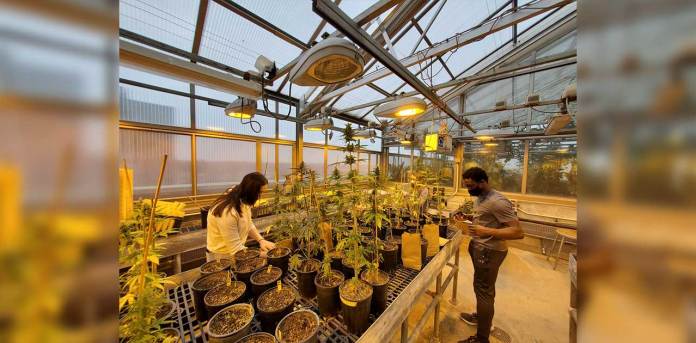
STEVENS POINT, WI (Submitted to OnFocus) – One hundred years ago, Wisconsin was second in the nation for growing hemp. Hemp is primarily grown for its fiber and cannabidiol oil (CBD). It is used to make ropes, plastics and other construction materials.
Although hemp cultivation was banned under the federal Controlled Substances Act in 1970, it has been allowed to resume under the Wisconsin industrial hemp bill. This allows licensed growers of hemp to produce and process hemp with a concentration less than 0.3% tetrahydrocannabinol (“THC”), a psychoactive substance.
This could be made possible by research at the University of Wisconsin-Stevens Point. Ten students and four faculty members in biology, chemistry, and natural resources are working together to demonstrate how hemp could once more be a major crop that not only generates income for Wisconsin farmers but also has positive impacts on the environment.
Our research is focused on using hemp for phytoremediation – the removal of toxins from soil, said Brian Barringer, an associate professor of biology in the College of Letters and Science and co-adviser on the project. The hemp plants can absorb heavy metals, such as arsenic and lead, and they can grow in them. This would allow Wisconsin farmers to diversify their agriculture and make a profit while cleaning up the environment.
Hemp can be used in a variety of ways and could soon become a more popular crop, according to Sophia Risch, Kimberly. She is a senior biology major and natural resource planning major and is also a researcher on this project. She stated that hemp can produce more textiles per acre than four acres of forest. It is a fast-growing resource that can be more sustainable and lucrative than other resources.
Risch stated that one-third of the world’s soil is polluted. In Wisconsin, there is a problem with soil degradation and a lack of nutrients. Even in poor soil, hemp can grow.
Barringer is licensed to grow the plants. He also uses it for a second research project on wild hemp cultivation in Wisconsin. Bryant Scharenbroch, associate professor of waste and soil resources in the College of Natural Resources at UW–Stevens Point, is co-adviser on both of these projects.
Students and faculty grew seedlings of Colorado Cherry Wine hemp, a variety commonly grown for CBD production. Then, they transferred them into soils that were treated with different amounts of fertilizer, arsenic, and lead to find out how these conditions affected their plants.
Barringer said that students were involved in every aspect, from the initial conception of the experiment to the overall design of the study to its execution and interpretation.
The students have been caring and analyzing plants for the last two semesters. They also measured and analysed the soil’s pH and electroconductivity. They also measured and recorded the rates of photosynthesis, chlorophyl production, and the soil’s rate of pH. The student researchers were able to quantify the amount of CBD and THC produced in flower tissue and determine how the plants took up and stored the lead and arsenic in their tissues. They are also analysing and interpreting the data and creating a poster that summarizes all their research.
Assistant Professor Shannon Riha, chemistry, assisted with a process calledhigh-performance liquid chromatography (HPLC), which separates compounds of the plant and identifies individual components such as CBD and THC. Assistant Professor Ann Impullitti from biology assisted with aspects related to plant physiology. Both were co-advisers for the project.
Risch said she enjoyed the project that brought together professors and students from two colleges. We all benefit from each other’s perspectives and need to be there for each other. Our professors have a wealth of knowledge and 10 students from diverse backgrounds made it easier to do the research faster and more efficiently. This also allowed us to expand our learning.
Barringer stated that the results of this research will inform future directions in research on this economically important and sustainable crop. This is supported by both political parties in the state, and it pleases both.
Research in the Rotunda, Wednesday March 9, will feature the research. The annual event, which is held at Madison’s Capitol, highlights the work of students from the UW System and gives them an opportunity to share it all with legislators.
Risch stated that this is also an opportunity to discuss the possibilities of expanding hemp farming in Wisconsin.
She stated that one of the most important aspects of research is to share your findings with others and hopefully make positive changes.
We would love to hear your stories! Send us your stories at [email protected]!
